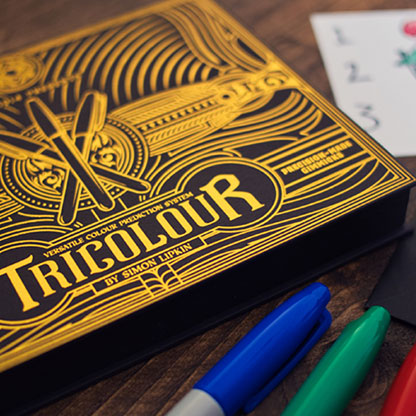First up, Simon Lipkin is an acquaintance of mine. I like him, I suspect it is impossible not to. He has such a boundless enthusiasm for magic (close-up mentalism in particular) like a puppy dog always looking for the next way to make something better or be better himself.
You show 3 pens which are different colours but their colour identity is hidden as they all have black lids. Your participant freely chooses a pen and you remove an envelope from your pocket from which you hand them a card with 3 numbered pictures to colour in. They colour in the first picture, then select another pen and colour in the second and finally the third picture.
You pick up the envelope which has been in full view, remove a prediction matching the colours and pictures.
I don’t think you can fault the effect, otherwise it wouldn’t have been around for so long, the freedom of choice the participant has makes this so strong.
Simon has made some choices to bring this into the walkaround realm. Instead of the usual five pens you have just three, which logically reduces the number of possible outcomes and yet it doesn’t impact the strength of the trick. The events are so random, the selection so honest that a prediction seems impossible.
Having less pens makes this more suitable for close-up. It is now a punchy 4 minute close up effect not a drawn out 10 minute stage one. You can still involve 3 people if you wish without the trick dragging on or getting repetitive.
He has also decided to ditch the usual single picture that is coloured in to three separate numbered drawings. Simon doesn’t like the way the magician traditionally just randomly selects which part is coloured after the pen is selected. He has a bloody good point and Tricolour is more baffling because of it.
This does mean you need the special envelope though, but Simon’s thinking and routining turns that into a strength. The envelope is (seemingly) on the table before the trick has begun as it is logically introduced to get the billet. Simon doesn’t mention the prediction inside, which is clever as it doesn’t give away the climax of the routine. It is always more engaging if the audience doesn’t know where a trick is going right from the start.
The rest of the method is probably the smartest. The pens are readily identifiable with a quick glance thanks to a marking system which is gloriously simple, fool-proof and as close to invisible as you can possible get.
You also get two other full routines using the pens, a drawing duplication, which uses a utility peek from Lewis LeVal. It is a good routine but the pen colour divination is secondary to the actual drawing duplication.
The third idea gives the colour match a run for its money. It is reminiscent of a chair test but obviously no are chairs involved. It is a real fooler.
The tutorial is broken down nicely into chapters, with recaps and overviews. Simon shares titbits of the psychology along the way too, which will help you make it play as strong as possible.
The big rub is the price, at £50 it isn’t a bargain and I know some people will balk at what you receive for your money. I’m sure if The 1914 didn’t go through Murphy’s it would be significantly cheaper and that would make it a no brainer. As it is, you need to consider whether this is something you will use time and time again. Sometimes the simple ideas are the hardest to sell.
The Tricolour system is a utility tool and this project gives you two excellent effects which you can easily customise them to suit your style and they are very easy to do.
There are definitely more uses for Tricolour to come. Have fun!

